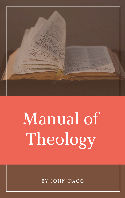This post is simply a youtube.com video to help you go through this process.
More Articles from this Category
- Using the Commentary Template
- Topic Formatting issues revisited
- Topic formatting Issues
- theWord hyperlink creation in theWord
- The End all of Text Manipulators
- Simple Bible Reader
This is a tutorial that explains how to convert PUBLIC DOMAIN Online Bible modules (onlinebible.org) to theWord (theword.net) which can then be converted to Android MySword Bible modules (mysword.info). Please do not convert copyrighted Bibles, like NIV, NASB, NLT, etc. Also, you need to download and read the instructions.

Dagg Manual of Theology is a theology work in 2 volumes by J.L. Dagg a Reformed Southern Baptist. It is an extensive, very ample presentation of doctrines.
This is an extensive Bible Systematic Theology (Bible Doctrines book) from a conservative point of view.
Read/Download: now with pdf download link. 50,000 views on this page with download link
Note as of Aug 7th 2021
Note that in theWord, all Bibles are just straight ASCII text files. That is, there should be no formatting in these files, just text and a single paragraph mark at the end of each verse. There are three types of these files. 1) The Old Testament. 2) The New Testament. 3) The entire Bible.
These files are distinguished by their file extension, i.e. .ot, .nt or .ont
In an Old Testament Bible module file, the first verse is Genesis 1:1. In a New Testament module file, the first verse is Matthew 1:1. In a whole Bible module file, again the first verse is Genesis 1:1.
The Benefits
The benefits with this setup outweigh the problems. The benefit is that with any word processor you can edit one of these files. There is no “converting” the file to theWord format, because the program wants it and requires it to be a straight ASCII text file.
The Problems
Getting around
To be truthful, I have not really made a whole lot of Bible modules for theWord, actually none. But I have opened and examined and played around with this some. The problem that comes in very hard on this situation is if you want to make your own Bible file, thing that I really don’t even need to do because I use the KJV, but if you do want to do that, then “getting around” in such a module presents somewhat of a problem. It is difficult to tell where you are in the Bible, or to just go to a certain place in the Bible, that is difficult. Since it is straight ASCII, you can open a copy in your word processor, make changes and save it, and then open theWord to that Bible and see what you did rather easily.
Extra paragraph marks.
There is a lot of problems in extra paragraph marks. To be truthful, most people don’t have a clue about formatting marks, and they should undertake to study this before even begin thinking about editing a Bible module. I would recommend using LibreOffice for this and turning on see all formatting. Study what is the difference between a linefeed and a paragraph mark. In the Psalms, you will find a lot of formatting that uses paragraph marks that need to be converted by hand to linefeeds. Sorry this is just how it is. No help on how to mass convert these.
In fact, if you are not so inclined to such brute editing, you should stay away from editing a Bible module in any Bible software. Bibles are not meant to be editable, notwithstanding today’s modernists that think otherwise.
Directives
If you are familiar with esword’s directives that address the label name and introductory notes for Bibles, theWord has the same. Go to theWord.net and get that information on what they are and how they change things. Note that in this directives and introductory section, it is after last verse of the last chapter of Revelation, and so paragraph marks are welcome there.
Translator’s Footnotes and Cross References
The only reason that I would embark on editing and creating a new Bible module would be to add translator’s footnotes and cross references. These would end up actually in the Bible itself, and you can do the same thing by just making a simple commentary module and adding these things there, but then the user would have to open that commentary to see them, whereas in the Bible it would be natively there. Caveat: If the user doesn’t know how to open cross references (click in Bibleview window and type a simple x) or translator notes in a Bible module (click in Bibleview window and type a simple f), he will be totally ignorant of these things you added anyway. :( Note that you can turn on or off these things by clicking on the bottom most “cog” icon in the Bibleview window and selecting “Footnotes and Translator Notes”. Besides turning these two on and off, there are options here also as to where these notes are positioned for the user. theWord is truly a very versatile Bible program. It is not shoddy. It was made with a tremendous number of bells and whistles that puts other commercial programs to shame.